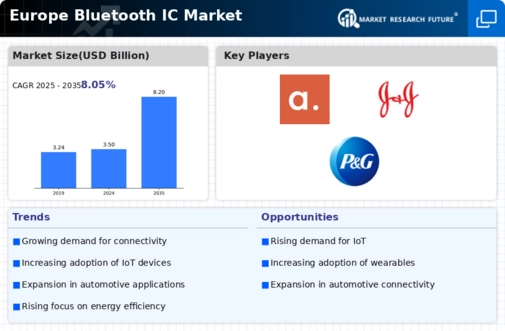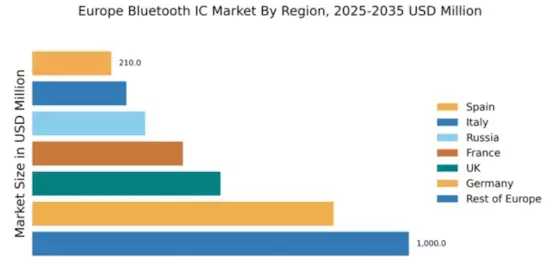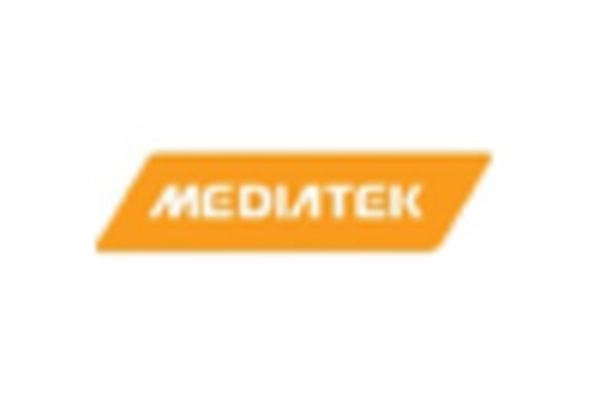Growth of Smart Home Devices
The proliferation of smart home devices is a significant driver for the The proliferation of smart home devices is a significant driver for the market in Europe.. As consumers increasingly seek convenience and automation in their living spaces, the demand for smart home products such as smart speakers, thermostats, and security systems is on the rise. In 2025, the smart home segment is projected to contribute approximately 30% to the bluetooth IC market. This growth is attributed to the integration of bluetooth technology, which allows for seamless communication between devices. Moreover, the trend towards home automation is likely to encourage manufacturers to develop more advanced bluetooth ICs that support multiple connections and enhanced security features. As the smart home ecosystem expands, the bluetooth ic market in Europe is expected to experience robust growth, driven by consumer preferences for interconnected and intelligent living environments.
Expansion of Automotive Applications
The automotive sector is increasingly integrating bluetooth technology, significantly impacting the The automotive sector is increasingly integrating Bluetooth technology.. With the rise of connected vehicles, the demand for bluetooth ICs is expected to grow as they facilitate hands-free communication, navigation, and entertainment systems. In 2025, the automotive segment is anticipated to represent around 25% of the bluetooth IC market. This shift is driven by regulatory requirements for safety and connectivity features, compelling manufacturers to adopt advanced bluetooth solutions. Furthermore, the trend towards electric vehicles (EVs) is likely to enhance the need for bluetooth ICs, as these vehicles often incorporate sophisticated infotainment systems. As automotive technology continues to advance, the bluetooth ic market in Europe is likely to benefit from increased investments in research and development, leading to innovative applications and enhanced functionalities.
Advancements in Industrial Automation
The The market in Europe is being propelled by advancements in industrial automation. is being propelled by advancements in industrial automation. As industries increasingly adopt smart technologies to enhance operational efficiency, the demand for bluetooth-enabled devices is on the rise. In 2025, the industrial automation sector is projected to represent approximately 20% of the bluetooth IC market. This growth is driven by the need for reliable wireless communication in manufacturing processes, where bluetooth ICs facilitate data exchange between machines and control systems. Furthermore, the trend towards Industry 4.0 is likely to accelerate the adoption of bluetooth technology, as companies seek to implement IoT solutions for improved productivity. As industrial automation continues to evolve, the bluetooth ic market in Europe is expected to experience significant growth, driven by the integration of advanced bluetooth ICs in various applications.
Surge in Consumer Electronics Adoption
The The market in Europe is experiencing a notable surge due to the increasing adoption of consumer electronics. is experiencing a notable surge due to the increasing adoption of consumer electronics. Devices such as smartphones, tablets, and wearables are becoming ubiquitous, driving the demand for efficient and reliable bluetooth ICs. In 2025, the consumer electronics sector is projected to account for approximately 40% of the total bluetooth IC market. This trend is further fueled by the growing preference for wireless audio devices, including headphones and speakers, which require advanced bluetooth technology for seamless connectivity. As manufacturers strive to enhance user experience, the integration of bluetooth ICs in these devices is likely to become more sophisticated, leading to innovations in sound quality and connectivity range. Consequently, the bluetooth ic market in Europe is poised for substantial growth as consumer electronics continue to evolve and expand.
Increased Focus on Health and Fitness Technologies
The The market in Europe is witnessing growth due to the rising focus on health and fitness technologies. is witnessing growth due to the rising focus on health and fitness technologies. Wearable devices, such as fitness trackers and smartwatches, are becoming increasingly popular among consumers who prioritize health monitoring and fitness tracking. In 2025, the health and fitness segment is estimated to account for about 15% of the bluetooth IC market. This trend is driven by the growing awareness of health issues and the desire for personalized health solutions. Bluetooth ICs play a crucial role in enabling these devices to communicate with smartphones and other applications, providing users with real-time data and insights. As the demand for health and fitness technologies continues to rise, the bluetooth ic market in Europe is likely to benefit from innovations that enhance device functionality and user experience.















Leave a Comment